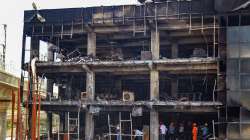Mundka fire: Forensic experts find more DNA profiles than 27 identified victims
Mundka fire: Twenty-seven people were charred or asphyxiated after the blaze engulfed a commercial building in Mundka area on May 13.

Mundka fire: DNA profiles of four additional people, other than that of the 27 victims of the massive fire incident in Mundka in May, have been found by the Forensic Science Laboratory (FSL). The samples have been preserved to help in identification in the future, according to officials.
Experts at Rohini's FSL stumbled upon this while they were identifying the charred bodies with the help of DNA profile generation and matching them with the samples of the respective claimants in a two-month-long investigation.
"A total of 27 bodies were identified and handed over to the claimants. However, during the process of examination by our experts, some additional DNA profiles, which did not have any claimants, were generated. Such profiles have been preserved for future reference," FSL director (Rohini) Deepa Verma said.
"In future, there are chances that someone may make claims about any of their family member's presence at the tragedy. In such circumstances, additional DNA profiles preserved with us can be used for identification," she added.
Mundka fire incident: 27 had died in massive blaze
Twenty-seven people were charred or asphyxiated after the blaze engulfed a commercial building in Mundka area on May 13. The fire started from the first floor that housed a CCTV camera office and router manufacturing and assembling company.
The Delhi Fire Service had deployed cranes to rescue those trapped in the blaze which was doused after nearly seven hours. However, smoke from the fire had spread to the entire building and some people jumped off through the windows to save themselves, while some others used ropes to climb down.
For the forensic examination, four officers were deputed under DS Paliwal, head of the Division of Biology and DNA. Paliwal had in 2005 supervised the DNA analysis and identification process in the Sarojini Nagar blast which had claimed the lives of more than 100 people.
"At the scene of crime, all remaining parts of the charred bodies, some flesh which was found to be melted and highly decomposed were collected, making it a big challenge for the forensic experts to identify all the 27 bodies," Paliwal said.
Talking about the challenges, he said the bodies were highly decomposed and that made it difficult to identify them and also took a long time. The foul smell from them made it an even more difficult task to completely preserve the sample and its proper collection and proper isolation.
The time period consumed in identification of bodies mainly depends on the nature of the exhibits.
Sharing details of the investigation, Paliwal said that even though some of the bodies were identified by relatives or family members but they did not have any scientific evidence.
"Since the bodies were completely charred, they were identified on the basis of rings, garments, chains or ornaments found. Exhibits like skeletal remains of the charred bodies collected from the scene of crime were sent to FSL. Doctors at Sanjay Gandhi Memorial Hospital where the charred bodies were kept in the mortuary for post-mortem were instructed to collect bones and molar teeth from these bodies. Once collected, they sealed the exhibits and sent them to FSL," he said.
The senior scientist further explained that besides the samples given, there were some remaining parts of the bodies which were very tiny.
"These were collected by the forensic experts at the spot. Even in those samples, our experts were able to extract DNA samples. But we still have certain samples which do not have any claimants. We have kept these DNA profiles preserved safely for future reference," he added.
Delhi Police had last month informed that a victim's body was handed over to another family "by mistake" which was rectified using the DNA profile.
While the victim's husband had identified her body by her turtle-shaped ring and two bangles -- the items that remained intact on her charred body, the real identity was established only after the forensic examination.
SK Arora, Medical Superintendent of Sanjay Gandhi Memorial Hospital, said that the biggest challenge was that since all the 27 bodies were kept in their mortuary, it was difficult to pacify the relatives of the deceased who kept frequenting the hospital seeking bodies and questioned the delay in the identification process.
"For them, they just wanted the bodies of their loved ones to perform their last rites but without proper identification through the scientific process by the FSL, we could not even perform the post-mortem.
"So, as per FSL's direction, we collected molar teeth and large bones from these charred bodies and handed them over to the experts at the laboratory who then generated the DNA profiles and re-matched them with the blood samples of the claimants after which we called the relatives of the deceased and showed them the body and performed post-mortem," he added.
(With inputs from PTI)
Also Read | Delhi Mundka Fire: Meet real life hero who saved 50 people trapped in ill-fated building